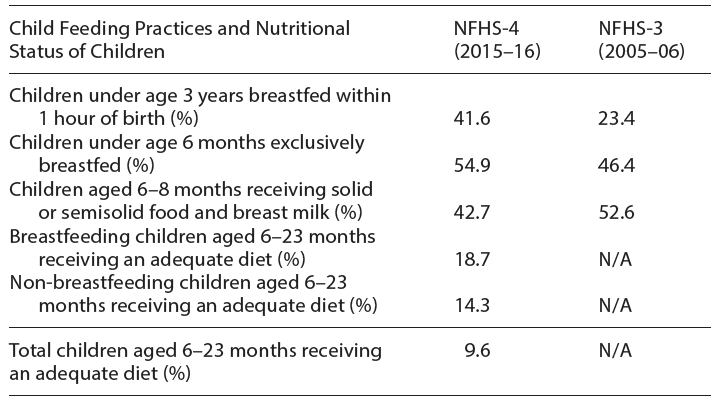When Does It All Begin: What, When and How Young Children Are Fed
Summary
The first two years of life are a critical period to promote proper nutrition and dietary behaviors for optimal growth and development. Yet, almost 700 million children worldwide are suffering from malnutrition [1]. While undernutrition remains a significant problem, there continues to be an increase in the number of children who are becoming overweight as we undergo the nutrition transition. This transition is causing a shift in both dietary intake and physical activity that can impact childhood growth and development. Thus, there is a need to identify recommendations and interventions that will adequately prevent both the under- and overnourishment of children starting in infancy.
Exclusive breastfeeding is recommended until 6 months with the addition of safe, nutritionally adequate complementary foods. Caregiver adherence to international guidelines for feeding infants and toddlers varies depending on the setting, access to information and quality foods, and cultural beliefs [2]. The World Health Organization (WHO) infant and young child feeding (IYCF) indicators allow for the tracking and progress of these IYCF practices both within and across countries. Table 1 employs these indicators to assess the changes India has seen in their breastfeeding and complementary feeding patterns.
In the last 10 years, India has seen significant changes in their breast- feeding and complementary feeding patterns. These changes are evident in Table 1, which compares data from NFHS-4 from 2015 to 2016 to data from NFHS-3 from 2005 to 2006 [3, 4]. Breastfeeding initiation has increased by almost 20%, increasing the risk of longer exclusive breast- feeding duration and decreasing the odds of infant mortality. Addition- ally, exclusive breastfeeding improved by almost 10%. Children aged 6–8 months receiving solid or semisolid food and breast milk decreased by 10% [3, 4]. This suggests the need for more effective complementary feeding programs and policies along with breast milk promotion.
Caregiver feeding style also plays an important role in what foods and drinks are offered and whether young children accept those foods.
Table 1. Child feeding practices and nutritional status of children in India comparing NFHS-4 and NFHS-3

Feeding guidelines often include what is called ''Responsive feeding'' which is the importance of caregiver attention to child cues of hunger and satiety. A lack of responsive feeding has been shown to be associated with overnutrition, reduced odds of breastfeeding, and a higher risk of inappropriate feeding [5]. So, responsive feeding should be stressed within both guidelines and interventions as a method of encouraging proper child development.
While there are data on food consumption and dietary diversity in early childhood, the global literature on early childhood beverage consumption is limited. With the increased consumption and availability of sugar sweetened beverages, future research should aim to track both global food and beverage consumption among children under 2 years old and its impact on growth and development.
Overall, international feeding recommendations need to be fol- lowed to encourage proper growth and development in early child- hood. While the types of food and beverages children consume remain important, there is a growing recognition for the importance of the way children are fed. Continuous research of both responsive feeding and diet will be a powerful tool to improve early childhood growth and development.
References
1. Children: Reducing Mortality (March 7, 2019). Retrieved from: https://www.who.int/
news-room/fact-sheets/detail/children-reducing-mortality.
2. World Health Organization Global Strategy for Infant and Young Child Feeding
[PDF file], (2003. Retrieved from: https://apps.who.int/iris/bitstream/handle/10665/
42590/9241562218.pdf?sequence=1.
3. International Institute for Population Sciences – IIPS/India and ICF, 2017. National
Family Health Survey NFHS-4, 2015–16, India. Mumbai: IIPS.
4. International Institute for Population Sciences (IIPS) and Macro International, 2007.
National Family Health Survey (NFHS-3), 2005–06, India: Key Findings. Mumbai:
IIPS.
5. Thompson AL, Adair LS, Bentley ME: Pressuring and restrictive feeding styles influence infant feeding and size among a low-income African-American sample. Obesity
(Silver Spring) 2013;21:562–571.